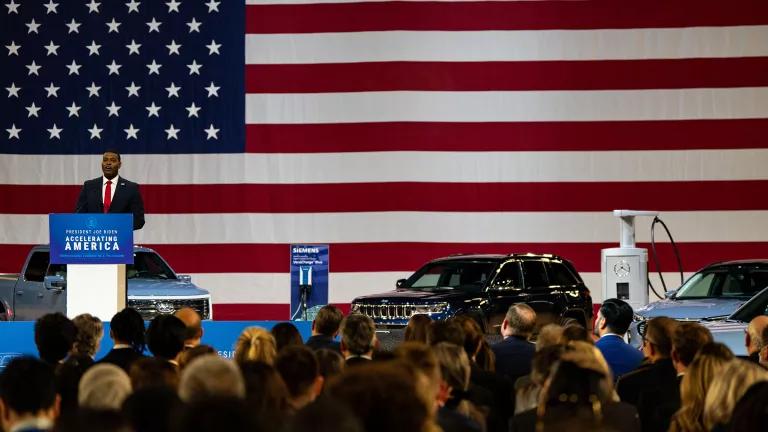
A new study released today finds that wider use of electric vehicles will produce billions of dollars in benefits for electric vehicle owners (fuel-cost savings), all utility customers (lower electric bills) and society at large (reduced climate-altering pollution).
The study focuses on the potential benefits of greater electric vehicle (EV) use in Massachusetts, which is among eight states that have set a goal to put 3.3 million zero-emission vehicles on the road by 2025.
Substituting clean cars for polluting gas-powered vehicles is critical to fighting climate change because transportation is the leading source of carbon pollution in a number of states, including Massachusetts where it accounts for about 40 percent of greenhouse gas emissions.
The study, conducted for NRDC by the consulting firm M.J. Bradley & Associates, examined the costs and benefits of increased EV use in the Bay State under two scenarios between 2030 and 2050. It also examined the additional benefits of encouraging EV owners to charge their vehicles during off-peak periods, when the grid is underutilized and power is cheaper.
Under one scenario, Massachusetts would achieve its goal of putting 300,000 electric vehicles on its streets by 2025 and increasing EVs at the same rate in later years until 2050, when 1.1 million EVs, or 20.6 percent of passenger vehicles, are in use.
Such a move would produce $5.4 billion in benefits by 2050, the study found.
Some 56 percent of the benefits would accrue to EV owners in lower vehicle operating costs; 21 percent to utility customers in the form of lower electric bills (from higher sales of electricity to power EVs); and 23 percent to society at large in the value of reduced climate damage. Among the benefits: a reduction of up to 2.1 million metric tons of greenhouse gas emissions.
Under the other scenario, the state would move even more aggressively, deploying enough EVs to achieve its goal of an 80 percent reduction in carbon pollution from 1990 levels by 2050. To do that, the state would need to replace most of gas-burning passenger vehicles on its roads with EVs by 2050.
The cumulative net benefits, however, would exceed $32 billion by 2050.
Among the benefits: a reduction of up to 6 percent in projected electric rates, resulting in an annual savings of about $139 per household. Also, a reduction of up to 11.3 million metric tons of carbon pollution.
The study provides further evidence of the value—to our heath, planet and pocketbooks—of making electric cars more available to the mass market—especially if the vehicles are charged from clean energy such as solar and wind power.
EVs can help us meet our climate goals, reduce harmful pollution, escape the pain at the pump from spikes in gasoline prices and strengthen the grid.
The study comes as EVs are gaining popularity with more affordable, longer-range electric vehicles—capable of traveling more than 200 miles between charges—arriving in showrooms.
The study also highlights the benefits of encouraging EV owners to charge their vehicles during off-peak times, when electricity is in greater supply and cheaper.
EV owners will generally start charging vehicles upon arriving home after work, increasing demand on the grid during a period of heavy use. Increasing the load during peak periods could necessitate new spending to expand the power system.
But if EV owners are given a nudge – in the form of financial incentives – many will put off charging until off-peak times, the study pointed out.
All utility customers – and the grid – would benefit more from off-peak charging because it would generate significant new revenues without large added costs
While the report focuses on Massachusetts, similar benefits are likely to be realized in other states, especially those where transportation is the single biggest source of carbon pollution and where residents are eager to get off the roller coaster of wild swings in gasoline prices.





